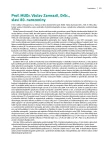Vitamin D and Polycystic Ovary Syndrome
Authors:
Ivica Lazúrová; Jana Figurová; Ingrid Dravecká
Authors‘ workplace:
I. interná klinika LF UPJŠ a UN L. Pasteura Košice, Slovenská republika
Published in:
Vnitř Lék 2016; 62(Suppl 3): 87-91
Category:
Reviews
Overview
Currently there is growing evidence on possible influence of vitamin D (VD) on reproductive function in both females and males. The relationship between VD and clinical or laboratory manifestations of polycystic ovary syndrome (PCOS) seems to be mostly evaluated. Patients with PCOS have been demonstrated to have significantly lower levels of serum VD and they also have the higher prevalence of vitamin D deficiency as compared to controls. Some studies documented the relation of VD to serum androgen levels, other found that VD correlated with metabolic parameters (body weight, insulin resistance and lipid profile) only. Several interventional studies demonstrated that VD replacement improved these metabolic parameters in PCOS women with VD deficiency. On the other hand some studies also documented improvement of ovarian function and androgen levels. Also vitamin D replacement may represent an additional treatment in VD deficient PCOS women with the aim to improve phenotypic manifestations. It requires further randomized interventional studies on larger groups of patients.
Key words:
metabolic syndrome – polycystic ovary syndrome – vitamin D
Sources
1. DeLuca HF. Overview of general physiologic features and functions of vitamin D. Am J Clin Nutr 2004; 80(6 Suppl): S1689-S1696.
2. Anagnostis P, Karras S, Goulis DG. Vitamin D in human reproduction: a narrative review. Int J Clin Pract 2013; 67(3): 225–235. Dostupné z DOI: <http://dx.doi.org/10.1111/ijcp.12031>.
3. Yamshchikov AV, Desai NS, Blumberg HM et al. Vitamin D for treatment and prevention of infectious diseases: a systematic review of randomized controlled trials. Endocr Pract 2009; 15(5): 438–449. Dostupné z DOI: <http://dx.doi.org/10.4158/EP09101.ORR>.
4. Holick MF. Vitamin D: a millennium perspective. J Cell Biochem 2003; 88(2): 296–307.
5. Lenz TL. Vitamin D supplementation and cancer prevention. Am J Lifestyle Med 2009; 3(5): 365–368. Dostupné z DOI: <http://dx.doi.org/10.1177/1559827609339280>.
6. Hewison M, Burke F, Evans KN et al. Extra-renal 25-hydroxyvitamin D3–1alpha-hydroxylase in human health and disease. J Steroid Biochem Mol Biol 2007; 103(3–5): 316–321.
7. Haussler MR, Jurutka PW, Mizwicki M et al. Vitamin D receptor (VDR)-mediated actions of 1α,25(OH)3 vitamin D3: genomic and non-genomic mechanisms. Best Pract Res Clin Endocrinol Metab 2011; 25(4): 543–559. Dostupné z DOI: <http://dx.doi.org/10.1016/j.beem.2011.05.010>.
8. Šašinka M, Furková K. Slnečný vitamín. Pandémia nedostatku vitamínu D. Herba: Bratislava: 2012 : 12 - 35. ISBN 9788089171903.
9. Dennis NA, Houghton LA, Jones GT et al. The level of serum anti-Müllerian hormone correlates with vitamin D status in men and women but not in boys. J Clin Endocrinol Metab 2012; 97(7): 2450–2455. Dostupné z DOI: <http://dx.doi.org/10.1210/jc.2012–1213>.
10. Nandi A, Sinha N, Ong E et al. Is there a role for vitamin D in human reproduction? Horm Mol Biol Clin Investig 2016; 25(1): 15–28. Dostupné z DOI: <http://dx.doi.org/10.1515/hmbci-2015–0051>.
11. Irani M, Merhi Z. Role of vitamin D in ovarian physiology and its implication in reproduction: a systematic review. Fertil Steril 2014; 102(2): 460–468. Dostupné z DOI: <http://dx.doi.org/10.1016/j.fertnstert.2014.04.046>.
12. Hahn S, Haselhorst U, Tan S et al. Low serum 25-hydroxyvitamin D concentrations are associated with insulin resistance and obesity in women with polycystic ovary syndrome. Exp Clin Endocrinol Diabetes 2006; 114(10): 577–583.
13. Selimoglu H, Duran C, Kyici S et al. The effect of vitamin D replacement therapy on insulin resistance and androgen levels in women with polycystic ovary syndrome. J Endocrinol Invest 2010; 33(4): 234–238. Dostupné z DOI: <http://dx.doi.org/10.3275/6560>.
14. Wehr E, Pilz S, Schweighofer N et al. Association of hypovitaminosis D with metabolic disturbances in polycystic ovary syndrome. Eur J Endocrinol 2009; 161(4): 575–582. Dostupné z DOI: <http://dx.doi.org/10.1530/EJE-09–0432>.
15. Kotsa K, Yavropoulou MP, Anastasiou O et al. Role of vitamin D treatment in glucose metabolism in polycystic ovary syndrome. Fertil Steril 2009; 92(3): 1053–1058. Dostupné z DOI: <http://dx.doi.org/10.1016/j.fertnstert.2008.07.1757>.
16. Thys-Jacobs S, Donovan D, Papadopoulos A et al. Vitamin D and calcium dysregulation in the polycystic ovarian syndrome. Steroids 1999; 64(6): 430–435.
17. Rashidi B, Haghollahi F, Shariat M et al. The effects of calcium-vitamin D and metformin on polycystic ovary syndrome: A pilot study. Taiwan J Obstet Gynecol 2009; 48(2): 142–147. Dostupné z DOI: <http://dx.doi.org/10.1016/S1028–4559(09)60275–8>.
18. Thomson RL, Spedding S, Buckley JD. Vitamin D in aetiology and management of polycystic ovary syndrome. Clin Endocrinol 2012; 77(3): 343–350. Dostupné z DOI: <http://dx.doi.org/10.1111/j.1365–2265.2012.04434.x>.
19. Glintborg D, Andersen M, Hagen C et al. Higher bone mineral density in Caucasian, hirsute patients of reproductive age. Positive correlation of testosterone levels with bone mineral density in hirsutism. Clin Endocrinol 2005; 62(6): 683–691.
20. Figurová J, Dravecká I, Javorský M et al. Prevalence of vitamin D deficiency in Slovak women with polycystic ovary syndrome and its relation to metabolic and reproductive abnormalities. Wien Klin Wochenschr 2016; 128, (17): 641–648. Dostupné z DOI: <http://doi:10.1007/s00508–015–0768–9>.
21. Dravecká I, Figuorvá J, Javorský M et al. The effect of alphacalcidiol and metformin on phenotype manifestations in women with polycystic ovary syndrome – a preliminary study. Physiol Res 2016. V tisku.
Labels
Diabetology Endocrinology Internal medicineArticle was published in
Internal Medicine

2016 Issue Suppl 3
Most read in this issue
- Congenital Adrenal Hyperplasia in Adults
- Multiple Endocrine Neoplasia I (Wermer‘s Syndrome), Forms of Clinical Manifestation, 5 Case Studies
- Vitamin D and autoimmune thyroid diseases
- Central Thyroid Disorders
